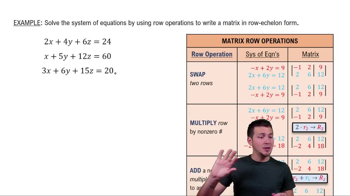Table of contents
- 0. Review of Algebra4h 16m
- 1. Equations & Inequalities3h 18m
- 2. Graphs of Equations43m
- 3. Functions2h 17m
- 4. Polynomial Functions1h 44m
- 5. Rational Functions1h 23m
- 6. Exponential & Logarithmic Functions2h 28m
- 7. Systems of Equations & Matrices4h 6m
- 8. Conic Sections2h 23m
- 9. Sequences, Series, & Induction1h 19m
- 10. Combinatorics & Probability1h 45m
7. Systems of Equations & Matrices
Introduction to Matrices
Problem 31b
Textbook Question
In Exercises 21–38, solve each system of equations using matrices. Use Gaussian elimination with back-substitution or Gauss-Jordan elimination. 
 Verified step by step guidance
Verified step by step guidance1
Write the system of equations in matrix form as an augmented matrix: \( \begin{bmatrix} 3 & -1 & -4 & | & 3 \\ 2 & -1 & 2 & | & -8 \\ 1 & 2 & -3 & | & 9 \end{bmatrix} \).
Use Gaussian elimination to create zeros below the first pivot (3 in the first row, first column) by replacing the second row with the result of multiplying the first row by \(-\frac{2}{3}\) and adding it to the second row.
Replace the third row with the result of multiplying the first row by \(-\frac{1}{3}\) and adding it to the third row to create a zero below the first pivot.
Continue with the second pivot (the new element in the second row, second column) and create zeros below it by replacing the third row with the result of multiplying the second row by an appropriate factor and adding it to the third row.
Perform back-substitution to solve for the variables \(a\), \(b\), and \(c\) once the matrix is in row-echelon form.
Recommended similar problem, with video answer:
 Verified Solution
Verified SolutionThis video solution was recommended by our tutors as helpful for the problem above
Video duration:
8mPlay a video:
Was this helpful?

 4:35m
4:35mWatch next
Master Introduction to Matrices with a bite sized video explanation from Patrick Ford
Start learningRelated Videos
Related Practice











